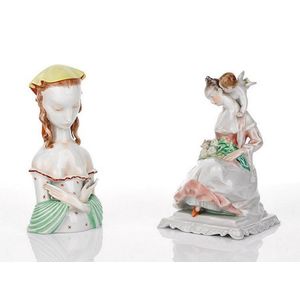Polychrome Porcelain Guanyin Figure with Child, Qing Dynasty
You must be a subscriber, and be logged in to view price and dealer details.
Subscribe Now to view actual auction price for this item
When you subscribe, you have the option of setting the currency in which to display prices to $Au, $US, $NZ or Stg.
- Biscuit Porcelain - Biscuit porcelain refers to unglazed, white porcelain that has been fired at a high temperature to harden the material and make it suitable for painting or glazing. The term "biscuit" comes from the French word for "unbaked," referring to the fact that the porcelain has not yet been glazed. The porcelain's firing process is done at very high temperatures and requires good quality of kaolin which is one of the material used to make porcelain.
- Qing Dynasty - The Qing Dynasty was the last imperial dynasty of China, ruling from 1644 to 1912. It was established by the Manchu people, who originated from the northeastern region of China. The Qing Dynasty was preceded by the Ming Dynasty and followed by the Republic of China.
- Polychrome - Made or finished in many colours. For furniture, it is used to indicated a painted finish.
- Ming Dynasty - The Ming Dynasty was a ruling dynasty of China from 1368 to 1644. It succeeded the Yuan Dynasty and preceded the Qing Dynasty. The Ming Dynasty was established by Zhu Yuanzhang, a former Buddhist monk who became a rebel leader and eventually overthrew the Mongol Yuan Dynasty. During the Ming Dynasty, China experienced a period of relative stability and prosperity. The government was centralized and bureaucratic, with the emperor at the top of the hierarchy. The Ming Dynasty is known for its cultural achievements, including the development of porcelain, the invention of movable type printing, and the construction of the Great Wall of China.
This item has been included into following indexes:
- Chinese ceramics, item type - figurines 1,568
- Oriental deities, other materials
Visually similar items

Herend porcelain figure group of maiden with cherub, c. 1940 together with Metzler & Ortloff porcelain bust of young lady, c. 1930 (2). Height 23 cm

A Chinese moulded figure of a monk, probably Republican Period, decorated in enamels, impressed seal mark to base. 19 cm high. Provenance: A Melbourne private collection

Australiana: rare 'Melbourne Argus' figured tobacco jar. 19th century English Staffordshire pottery. 25 cm

A Japanese ivory okimono figure of a geisha, Meiji period (1868-1912), wearing formal attire, elaborate headdress and carrying a box with a flower, two character signature on a red lacquer tablet, 17.5 cm high
